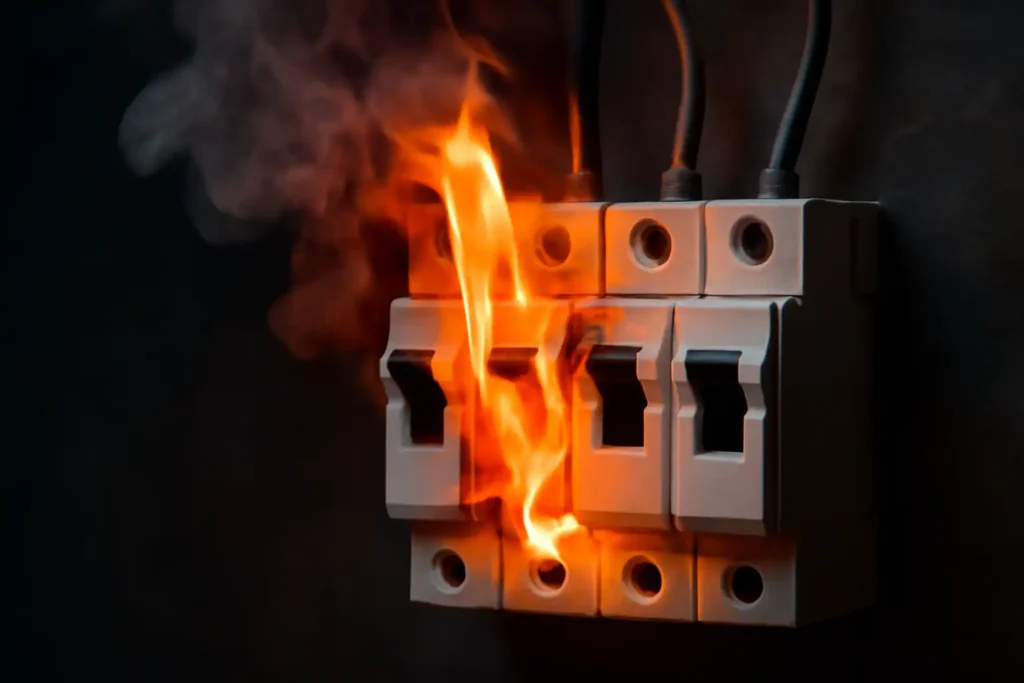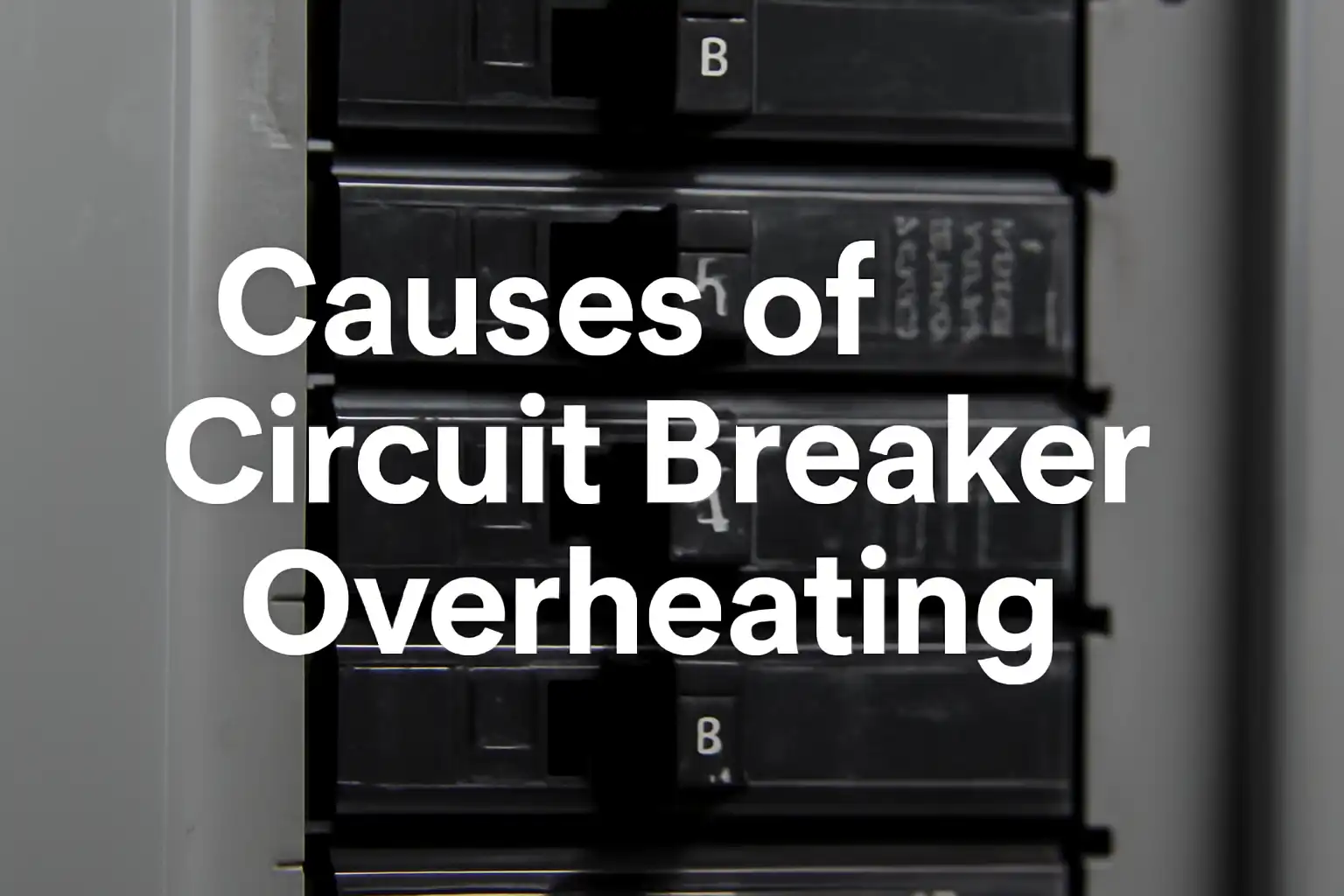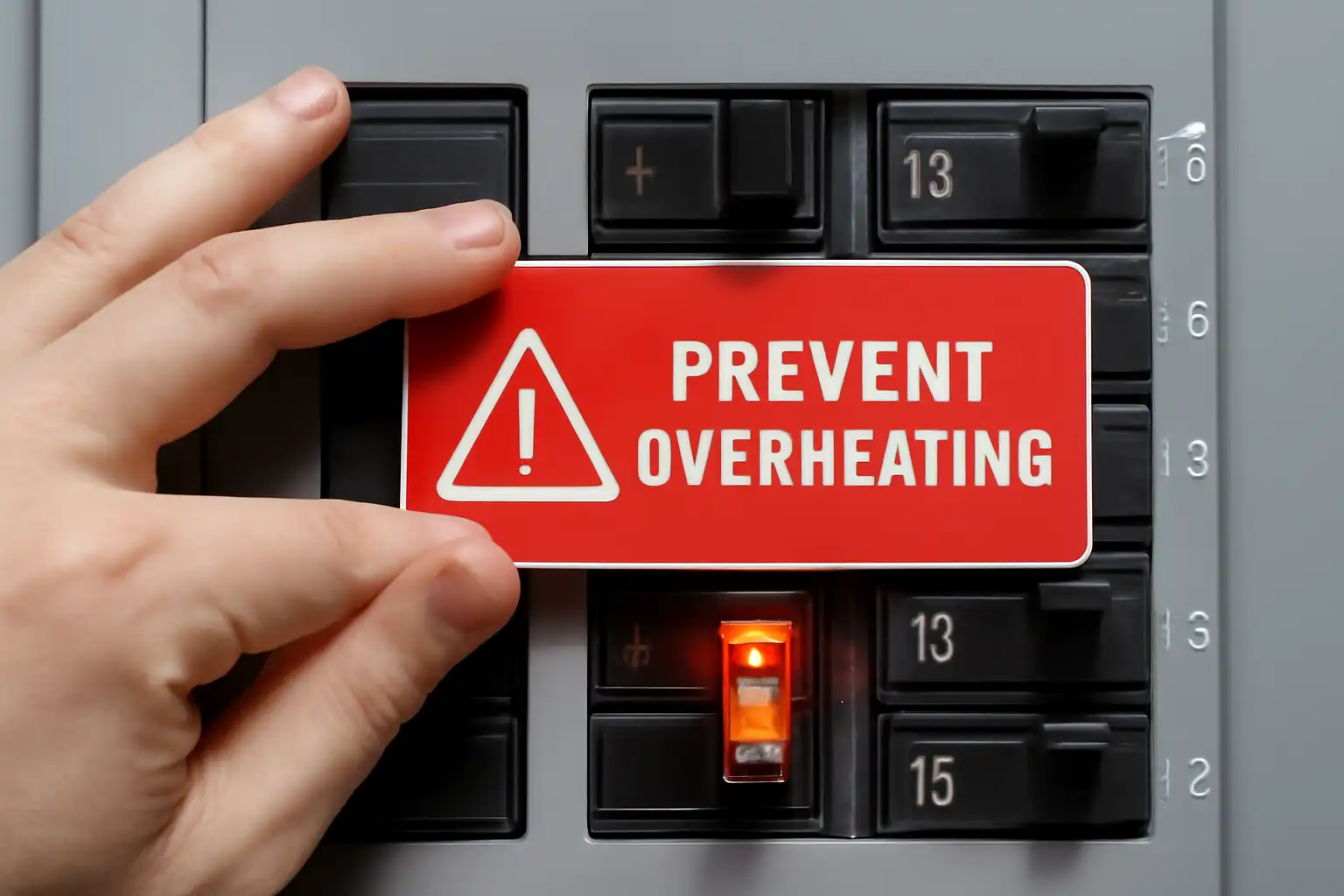Circuit breaker overheating occurs when they can’t manage electricity effectively. This can happen due to excessive power, loose wires, or high temperatures. If circuit breaker overheating is not addressed, it could damage devices or even ignite fires, so it’s important to resolve the issue quickly. Be alert for warning signs such as burning smells or excessive heat to ensure safety.
Key Takeaways
- Using too many devices on one circuit causes heat. Use different circuits to avoid this problem.
- Loose or bad connections make resistance, which creates heat. Check and tighten connections often to stay safe.
- Hot weather and moisture can harm circuit breakers. Keep the area clean and dry to protect them.
- Look out for signs like burnt smells or frequent trips. Fix these problems fast to prevent danger.
- Have an electrician inspect and maintain breakers regularly. This stops overheating and helps them last longer.
Causes of Circuit Breaker Overheating
Overloading Circuits
Using too many devices on one circuit can overload it. This happens when the circuit handles more electricity than it should. The breaker works harder to control the extra power, creating heat. Over time, this heat can make the breaker fail.
For example, running air conditioners, heaters, and microwaves on one circuit can overwhelm it. Too much power increases the current, heating up the breaker.
| Cause | Explanation |
|---|---|
| High Electrical Loads | Too many devices cause extra current and heat buildup. |
To avoid this, spread devices across different circuits. Don’t use power strips or extension cords to connect many appliances to one outlet.
Loose or Faulty Connections
Loose or bad connections can also cause overheating. Wires or terminals that aren’t tight create resistance. Resistance makes heat, which can harm the breaker and nearby parts.
For example, a loose wire in the breaker can cause poor contact. This might lead to sparks, increasing the chance of overheating.
| Cause | Explanation |
|---|---|
| Loose Connections | Loose wires create resistance, causing heat and damage. |
| Faulty Wiring | Bad wiring raises resistance, overheating the breaker. |
Check your connections often to prevent this. Tighten loose wires and replace damaged ones quickly. If unsure, ask an electrician to check the connections.
Environmental Conditions
The area around the breaker affects how well it works. Hot temperatures, bad airflow, and humidity can cause overheating. For example, a breaker in a stuffy space may not cool down properly.
Humidity can rust parts inside the breaker. Dust or dirt can damage the casing or cause electrical problems.
| Environmental Metric | Impact on Circuit Breakers |
|---|---|
| Temperature | High heat can cause overheating problems. |
| Humidity | Rust can harm electrical connections. |
| Contamination | Dirt can break the casing or cause failures. |
To stop these issues, install the breaker in a dry, airy spot. Keep the panel clean and free of dust. If your area is humid, use a dehumidifier to protect your system.
Aging or Faulty Circuit Breakers
Circuit breakers get old and wear out over time. As they age, their parts may weaken and stop working well. This makes it harder for them to control electricity safely. A faulty breaker might not shut off during an overload, which can cause overheating or even fires.
Older breakers may trip more often or be hard to reset. This could mean their parts are worn out. For example, springs inside might lose strength, or metal parts might rust. These problems make it harder for the breaker to handle electricity safely.
Tip: If your home has an old electrical panel, have it checked by an electrician. They can find old breakers and suggest replacements before they fail.
Breakers can also fail because of factory defects or bad installation. A defective breaker might not spread electricity evenly, causing hot spots and damage. Even new breakers can fail if installed wrong or used with the wrong wires.
To avoid problems with old or faulty breakers:
- Inspect often: Look for signs like strange sounds or burnt marks.
- Replace old breakers: Get newer ones that follow today’s safety rules.
- Test breakers: Use a tester to check if they shut off properly.
Ignoring old or broken breakers can lead to overheating and safety risks. Fixing these issues early helps protect your home and electrical system.
Warning Signs of Circuit Breaker Overheating
Burning Smell or Odors
A burning smell is a clear warning of overheating. You might notice a sharp, unpleasant odor like burning plastic or rubber. This often means the wire insulation is melting, which can cause a fire. If you smell this, turn off the power and call an electrician quickly.
Alert: A fishy or plastic-burning smell could mean a growing electrical fire. Ignoring it may lead to serious property damage.
Frequent Circuit Breaker Tripping
If your circuit breaker trips often, it signals a problem. This happens when the breaker can’t handle the electricity, often due to bad connections or too many devices. Frequent tripping disrupts your day and raises the chance of overheating or fires.
Studies show tripped breakers are a common sign of overheating. Knowing these signs helps you fix issues early and stay safe.
| Observation | Measurement | Notes |
|---|---|---|
| Voltage Drop A Phase | 50.4 millivolts | Normal range |
| Voltage Drop B Phase | 48.8 millivolts | Normal range |
| Voltage Drop C Phase | 41.4 millivolts | Normal range |
| Amp Load A Phase | 144.1 amps | Acceptable rating |
| Amp Load B Phase | 133.7 amps | Acceptable rating |
| Amp Load C Phase | 132.6 amps | Acceptable rating |
Visible Discoloration or Scorch Marks
Burn marks or discoloration near outlets or breakers are serious warnings. These marks show overheating and possible fire risks. Bad wiring or loose connections often cause this damage, which can harm your home or family if ignored.
Tip: Report burn marks or discoloration right away. Fixing them early keeps your home and system safe.
Signs like burnt outlets or marks mean the breaker is struggling. If you see these, call an electrician to check and fix the problem.
Excessive Heat When Touched
If a circuit breaker feels very hot, it’s overheating. This means there’s a problem that needs fixing right away. You can check by gently touching the breaker panel. If it feels hotter than usual, look into it immediately.
Too much heat happens because of loose wires, too many devices, or old parts. This heat can harm the breaker and nearby wires, which might cause fires. For example, a breaker handling too much power may not cool down well, leading to unsafe heat levels.
Alert: Don’t ignore a hot breaker. It can damage your system and cause danger.
Experts use special tools to check how hot breakers are. These tools show if the heat is safe or if repairs are needed.
| Measurement Tool | What It Does |
|---|---|
| Heat Index | Shows how hot it feels with humidity added. For example, at 96°F and 65% humidity, it feels like 121°F, which is very dangerous. |
| Wet Bulb Globe Temperature (WBGT) | Combines heat, humidity, wind, and sunlight to measure heat stress. |
If you find a hot breaker, turn it off and unplug devices. This lowers the load and stops more damage. Don’t touch the breaker for long to avoid burns or shocks.
To stop overheating, have regular check-ups and maintenance. An electrician can fix loose wires, replace old parts, and solve other heat problems. Catching issues early keeps your breakers safe and working well.
Tip: Keep the breaker panel clean and dust-free. This helps air move better and reduces heat.
Risks of Ignoring Circuit Breaker Overheating
Fire Hazards
Ignoring overheating can cause dangerous fires. Electrical fires start about 51,000 home fires yearly in the United States, leading to many deaths and over $1.3 billion in property damage. When breakers overheat, they melt wire coverings, causing sparks that can ignite nearby items. Older homes are at higher risk because their circuits often handle more devices than intended.
Tip: Act fast if you notice burning smells or scorch marks. Fixing small issues can stop big disasters.
Damage to Electrical Systems
Overheating can harm your home’s electrical system. Loose wires and too much current create resistance, which makes heat. This heat can melt wires, ruin outlets, and damage appliances. Faulty breakers that don’t trip allow overheating to continue, causing worse problems.
For example, a breaker that doesn’t shut off during overloads can damage your fridge or computer. Replacing these items costs money. Regular checks can catch problems early and protect your system.
Risk of Electrical Shock
Overheating raises the chance of electrical shock. Melted insulation or damaged wires expose live parts, which are dangerous. Touching an overheated breaker or outlet could cause a serious shock. Damp areas make this risk worse because water conducts electricity easily.
Alert: Don’t touch a hot breaker. Turn off power and call an expert to fix it safely.
Ignoring overheating risks your home and safety. Fires, system damage, and shocks can be avoided with proper care and quick action.
Higher Repair Expenses
Not fixing circuit breaker overheating can cost a lot of money. When a breaker gets too hot, it often harms other electrical parts. This includes wires, outlets, and connected devices. Fixing these is much pricier than solving the original issue.
For instance, one overheated breaker might melt nearby wires. This could mean rewiring a large part of your house. If the breaker doesn’t shut off during an overload, it might ruin costly appliances like fridges or air conditioners. Replacing these items can become very expensive.
Tip: Solving small problems early can save you from bigger, costly repairs later.
Why Do Repairs Cost More?
Several reasons make repairs more expensive when overheating is ignored:
- More Damage: Heat spreads and ruins nearby parts, needing multiple fixes.
- Extra Labor: Electricians take longer to repair bigger problems.
- Appliance Issues: Overheating can break expensive devices, raising repair costs.
| Problem | Cost Impact |
|---|---|
| Broken Wiring | May need rewiring |
| Burned Outlets | Requires replacement |
| Appliance Problems | High repair or replacement costs |
You can avoid these expenses by acting fast. Regular check-ups and maintenance catch problems early. If you notice signs like burning smells or frequent tripping, fix them right away.
Alert: Waiting to repair issues not only raises costs but also risks your safety.
By staying on top of maintenance, you save money and protect your home. Small fixes now prevent big, expensive problems later and keep your system working well.
Prevention Strategies for Circuit Breaker Overheating
Avoid Overloading Circuits
Overloading happens when too many devices use one circuit. This makes the circuit breaker work harder, causing heat and fire risks.
To stop this, spread devices across different circuits. Don’t plug high-power items like heaters or microwaves into the same outlet. Avoid using power strips or extension cords for many devices on one outlet.
Tip: Label your breakers to know which outlets they control. This helps you balance the load and avoid overloading.
Perform Routine Maintenance
Regular maintenance keeps your circuit breakers working well. It helps find problems early, stopping overheating or failure. Maintenance also improves safety and makes breakers last longer.
Benefits of regular maintenance include:
- Prevents breakdowns and keeps systems reliable.
- Improves safety by ensuring proper operation.
- Reduces risks from faulty systems.
- Saves money by avoiding costly repairs.
You can test breakers to check their performance. Common tests include:
| Test Type | Purpose |
|---|---|
| Regular Testing | Ensures breakers work properly and lowers risks. |
| Testing Methods | Includes resistance and insulation checks to find issues early. |
| Proactive Maintenance | Spots wear before failure, saving money and extending breaker life. |
Note: Check your breakers yearly. If you see signs like burning smells or frequent tripping, call an expert quickly.
Ensure Proper Installation and Connections
Good installation and tight connections prevent overheating. Loose wires or bad setups create resistance, which makes heat and harms the breaker.
Follow these tips for safe installation:
- Follow the National Electrical Code for safety.
- Plan for your electrical needs and space limits.
- Use correct mounting and wiring methods.
- Tighten all connections to avoid heat buildup.
Tip: Hire a licensed electrician for installations. They ensure your system is safe and works efficiently.
By using these steps, you can lower the chance of overheating and keep your home or business safe from electrical dangers.
Get Help from an Expert for Ongoing Problems
Some circuit breaker issues are too risky to fix yourself. Problems like constant tripping, burning smells, or too much heat need a licensed electrician. Trying to repair these without the right skills can cause more harm or serious dangers.
Why Call an Electrician
Electricians have the right tools and training to fix tough electrical problems. They can find hidden issues like broken wires or bad parts that you might miss. Experts also make sure repairs follow safety rules, lowering the chance of future trouble.
Tip: If your circuit breaker keeps overheating, act fast. A professional can stop small problems from becoming big, costly, or dangerous.
When to Ask for Help
Call an electrician if you notice:
- Frequent Tripping: Breakers that trip a lot may signal bigger problems.
- Burning Smells or Scorch Marks: These could mean overheating or fire risks.
- Old Panels: Older systems may not handle today’s power needs.
- Ongoing Overheating: If the breaker stays hot after reducing the load, get help.
What Electricians Do During a Check-Up
When inspecting, an electrician will:
- Check Wires: They’ll make sure all connections are tight and safe.
- Test the Breaker: Special tools measure heat and electricity flow.
- Inspect the Panel: They’ll look for rust, dirt, or worn-out parts.
- Suggest Upgrades: If needed, they’ll recommend safer, updated systems.
| Service Done | Why It’s Important |
|---|---|
| Wire Check | Ensures connections are secure and working well. |
| Heat Testing | Finds overheating or unusual heat spots. |
| Panel Inspection | Spots rust, dirt, or other damage. |
| Upgrade Suggestions | Helps meet modern safety and efficiency standards. |
Why Hiring a Pro Helps
Getting expert help saves time and keeps your home’s electrical system safe. It also prevents problems from coming back, which can save money on repairs. Fixing circuit breaker overheating early protects your home and family from danger.
Alert: Don’t ignore ongoing electrical problems. Waiting to fix them can lead to fires, shocks, or expensive damage.
Taking quick action now avoids bigger issues later. Trusting a professional ensures your system stays safe and works properly.
Overheating in circuit breakers can be dangerous for your home. It harms insulation and may cause the breaker to stop working. Checking your system often and watching for high temperatures can help you spot issues early. This saves money on repairs and keeps your home safe. Knowing what causes overheating and its warning signs lets you act quickly to protect your electrical setup. Getting help from an expert ensures safety and lowers the chance of fires or damaged devices.
- Heat ruins insulation and weakens circuit breakers.
- Regular checks stop problems and keep systems working well.
Tip: Check your system regularly to avoid big repairs and stay safe.
FAQ
What causes circuit breakers to overheat?
Circuit breakers overheat because of overloading, loose wires, bad environments, or old parts. These problems make heat build up, which can harm the breaker and nearby systems.
What should you do if a breaker feels hot?
Turn it off right away and unplug devices. Don’t touch it for long. Call an electrician to check and fix the problem safely.
Alert: A hot breaker can cause fires or shocks if ignored.
How often should you inspect circuit breakers?
Check your breakers once a year. Watch for burning smells, scorch marks, or frequent trips. Regular checks stop overheating and keep your system safe.
Can old breakers make overheating worse?
Yes, old breakers wear out and don’t work well anymore. Weak parts can’t handle power, which raises the chance of overheating. Replacing them makes your system safer.
What tools help electricians find overheating?
Electricians use heat sensors and thermal cameras to check for hot spots. These tools find problems fast and help with accurate repairs.
Tip: Expert inspections with special tools can save money and prevent damage.
The following information may be of interest to you
What Are the Signs of a Bad Circuit Breaker
Can I replace a 15 amp breaker with a 20 amp?
Comprehensive guide for wiring methods of air circuit breakers





